Oklahoma’s economy continued to expand in 2018. Employment increased solidly, especially in metropolitan areas, and most industries added jobs. The state’s unemployment rate continued to decline and is back below the national average, with wages rising. The energy sector was profitable, and expectations in the agriculture industry have improved slightly. Additionally, despite tariffs and trade uncertainty manufacturing exports grew and factories remain upbeat about 2019. With rising employment and positive outlooks across most industries, the outlook for Oklahoma’s economy heading into 2019 also appears positive, especially if commodity prices and trade discussions stabilize.
Continued job growth amid a tightening labor market
After falling in 2015 and 2016, employment in Oklahoma moved above year-ago levels in May 2017 and has grown since. For most of 2018, job growth in the state has exceeded the national rate (Chart 1). The latest data show Oklahoma employment was 1.4 percent higher than a year ago. Large metros in the state experienced even faster job growth in that period, with both Oklahoma City and Tulsa growing more than 2.0 percent.
Chart 1. Payroll Employment Growth
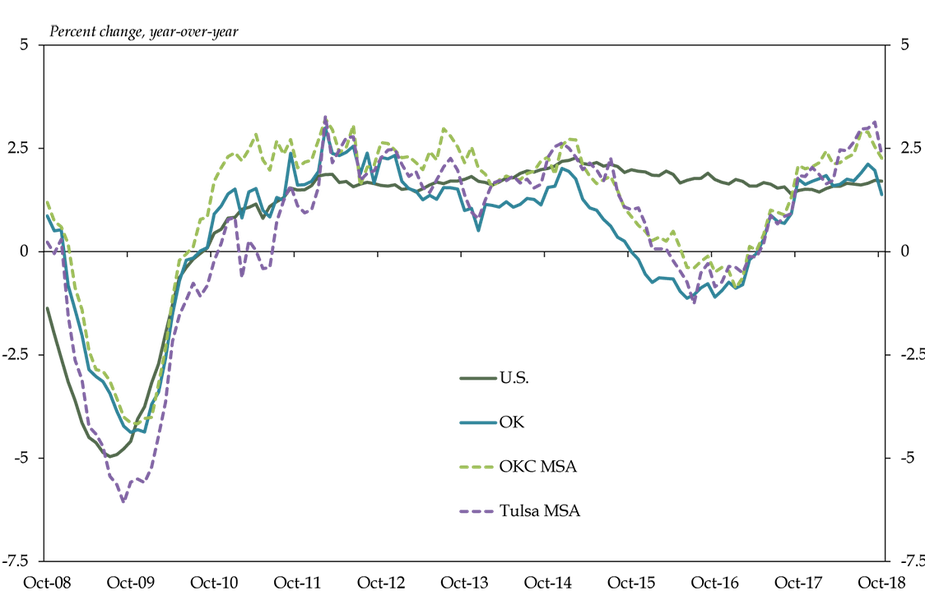
Source: Bureau of Labor Statistics
Most industries across the state in the last year have gained jobs. The largest and most consistent gains have been in mining (which in Oklahoma consists almost completely of oil and gas), followed by trade and transportation, leisure and hospitality and professional and business services (Chart 2). The weakest industries have been construction and financial activities, as housing activity has slowed. Single-family housing permits in Oklahoma as of October were down 2 percent from a year ago._
Chart 2. Oklahoma Employment Growth by Industry
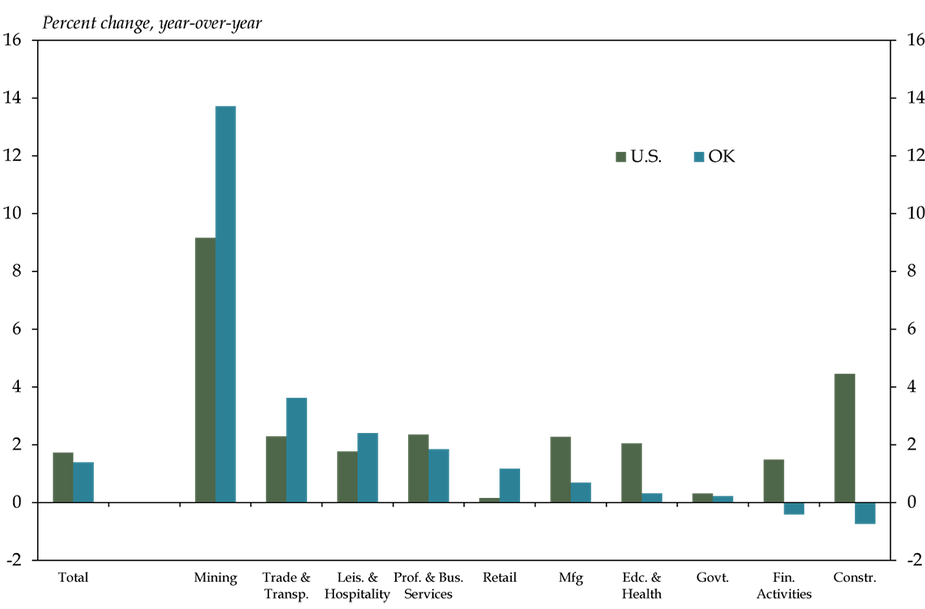
Source: Bureau of Labor Statistics
Broad employment growth in Oklahoma for the past 18 months has helped decrease the state’s unemployment rate. Since June 2018, the state unemployment rate has been below 4 percent, and below that of the nation (Chart 3).
Chart 3. Unemployment Rate
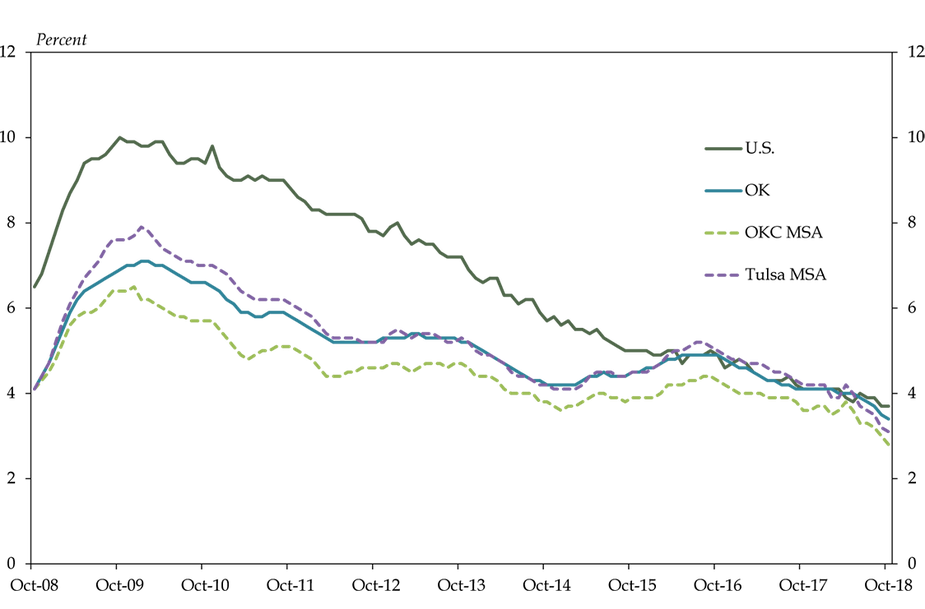
Source: Bureau of Labor Statistics
The latest unemployment rate for Oklahoma was 3.4 percent in October, the lowest level since May 2008; in the two large metropolitan areas joblessness was even lower. Also, 66 of Oklahoma’s 77 counties had unemployment rates less than 4 percent in October, with joblessness especially low in northwestern Oklahoma (Map).
Map. Oklahoma County Unemployment Rates, Seasonally Adjusted
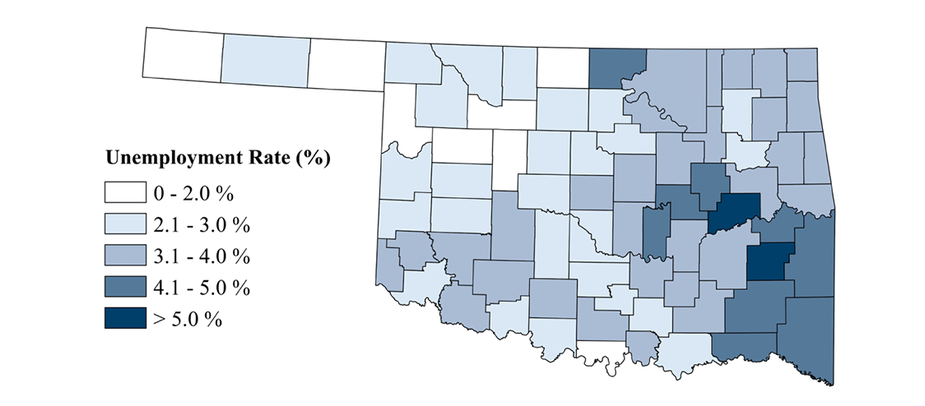
Source: Bureau of Labor Statistics
As Oklahoma’s labor market has tightened and job growth in high-paying industries such as oil and gas has been strong, average hourly average earnings have continued to improve (Chart 4).
Chart 4. Hourly Wage Growth
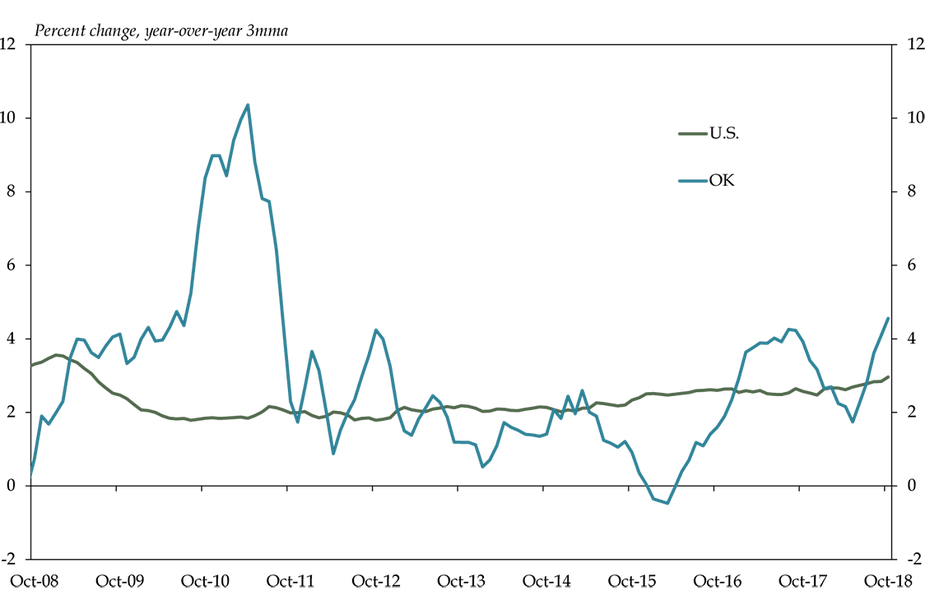
Source: Bureau of Labor Statistics
Similar to recent national trends, Oklahoma’s employment growth has varied by wage level. From 2017-18, Oklahoma’s high wage job sector has shown the most rapid growth compared with last year, helping boost overall average wages in the state (Chart 5).
Chart 5. Employment growth by Wage Level
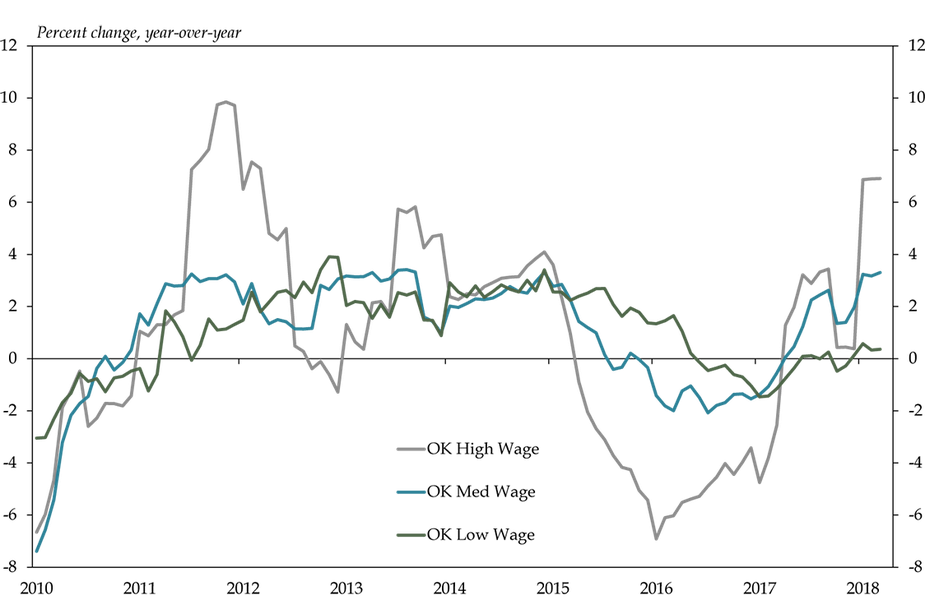
Note: High Wage: management; utilities; mining; finance and insurance; professional, scientific, and technical services; information. Medium Wage: wholesale trade; manufacturing; construction; transportation and warehousing; real estate, rental, and leasing; health care and social assistance. Low Wage: educational services; arts, entertainment and recreation; administration and waste management; retail trade; agriculture; accommodation and food service.
Source: Bureau of Labor Statistics QCEW data
Industry outlooks remain positive despite turbulence
The energy sector expanded in 2018, as drilling was profitable amid higher oil prices for much of the year (Chart 6). Rig counts ticked up, though not as much as in past expansions, as firms increasingly have been able to produce more with fewer rigs. While the price of oil fell to $51 per barrel in late November, prices remain near the level firms reported needing for profitability in the Kansas City Fed Energy Survey: $55 per barrel on average. Many firms also hedged production at higher oil prices earlier in the year, helping maintain profitability into 2019. In addition, a jump in natural gas prices late in the year has provided a boost in a period of lower oil prices.
Chart 6. Oklahoma Oil Rigs and Oil Prices

Sources: Baker Hughes, CME Group, EIA/Haver Analytics, FRBKC Energy Survey
Although conditions in the state’s important agriculture sector fluctuated in 2018, there was some improvement in the third quarter. Oklahoma farm income continued to edge lower but at a slower pace than previous quarters, and expectations for farm income have moved higher (Chart 7). The state’s agricultural conditions are also better than in other states in the Tenth District, which are more concentrated in corn and soybean production than in cattle. Agriculture remains one of Oklahoma’s primary export industries, and farm production exports from the state in the last year have increased.
Chart 7. Farm Income
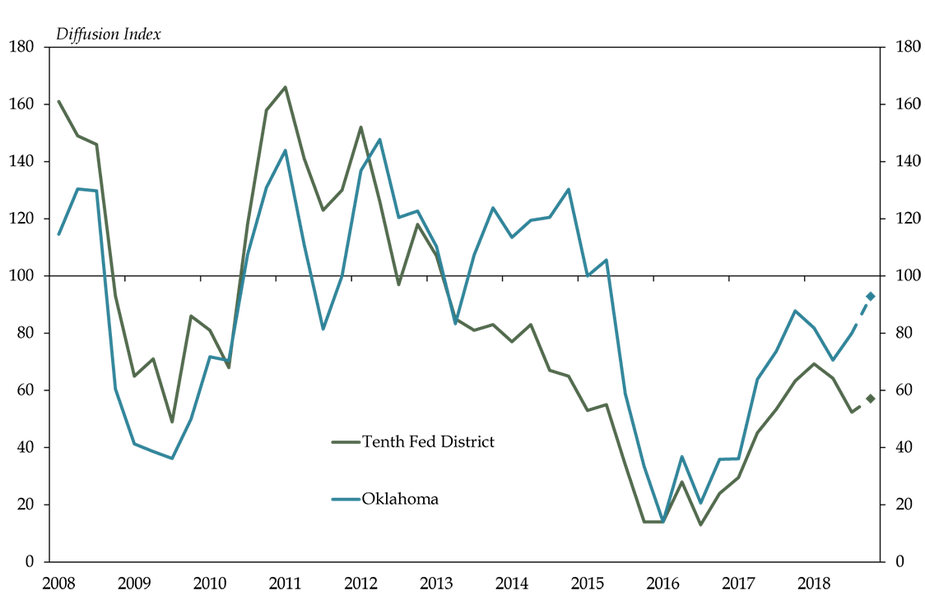
Source: FRBKC Agricultural Credit Survey
The manufacturing industry, another key sector in the state, continued to expand in 2018 throughout Oklahoma’s region, according to results of the Tenth Fed District’s monthly manufacturing survey (Chart 8). In addition, despite numerous trade discussions and tariff impositions, goods exports from Oklahoma and goods imports to the state remain up year-over-year across various industries. Factories in the region generally remain optimistic about the first half of 2019, according to expectations indexes in the regional survey.
Chart 8. Manufacturing Materials Prices vs. Exports
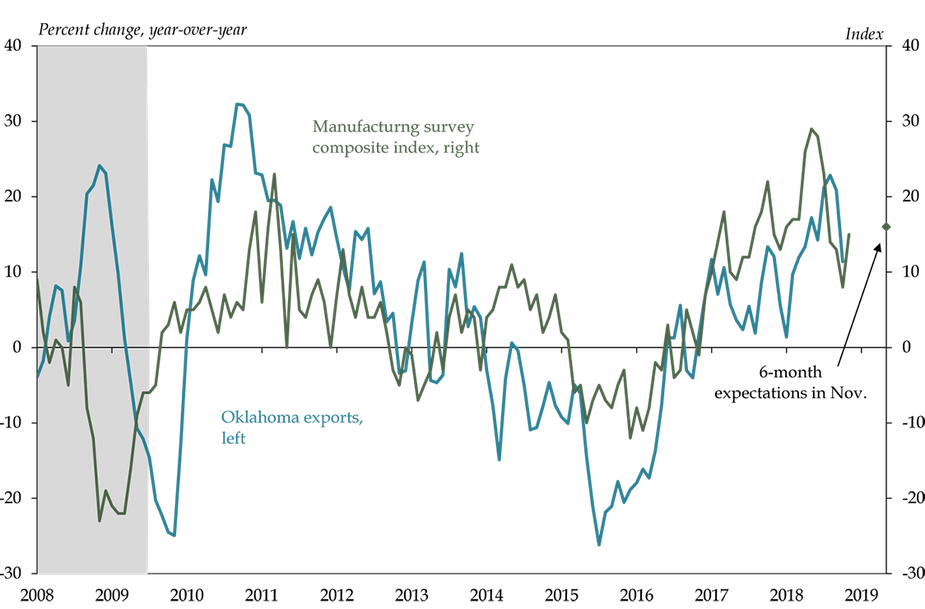
Note: Exports data shown as three-month moving average.
Sources: FRBKC, NBER recession shading, U.S. Census Bureau, WISERTrade
The state government’s tax revenues in the last year also improved following recent difficult years. Total state tax revenues in November were up 15.7 percent compared with the previous year (Chart 9).
Chart 9. Oklahoma State Tax Revenues
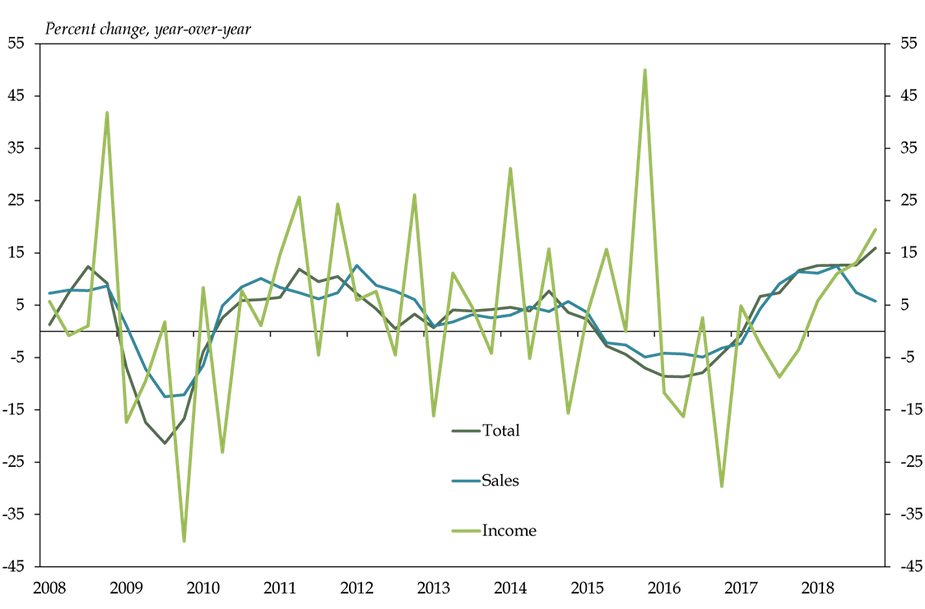
Note: Q4-2018 data through November
Source: OK Tax Commission
This rapid pace of expansion for total tax revenues, especially sustained growth, has not been seen in more than 10 years. State sales tax revenues have also grown considerably, though not as much as overall tax revenues in recent months. Income tax receipts tend to be more volatile, but currently are up 19.5 percent from last year. While the state budget suffered considerably following the state’s 2015 and 2016 recession, increased government tax receipts have put the state in a better fiscal position for future fiscal years.
Summary
Oklahoma’s economy saw continued expansion in 2018, building on growth in 2017 following the state’s economic downturn in 2015 and 2016. Growth was not limited to one sector of the economy, as the energy, manufacturing and services industries all posted solid increases while income in the agriculture sector showed some stability. Unemployment in the state continued to decline, falling below the U.S. unemployment rate while wage growth increased. The outlook for key goods-producing sectors in the Oklahoma economy generally is positive heading into 2019 despite tariffs and lower oil prices. Meanwhile, state tax receipts have been strong. Together, these factors suggest the state’s economy is on good footing heading into 2019.
______________________________________________________________________________
Endnotes
-
1
According to year-over-year percent change calculations using seasonally adjusted data obtained from the U.S. Census Bureau via Haver Analytics.
